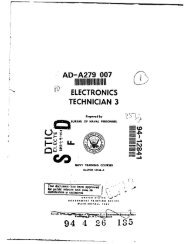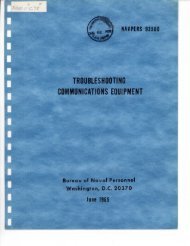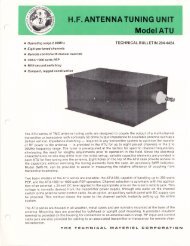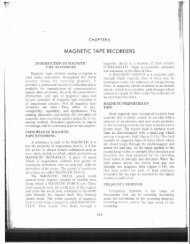L - VIR History
L - VIR History
L - VIR History
Create successful ePaper yourself
Turn your PDF publications into a flip-book with our unique Google optimized e-Paper software.
ELECTRONIC CIRCUITS NAVSHIPS<br />
for c0r:ect 3' :eslstcrce. '::c :r. :r-clrcbi: c,;;:c!tsr<br />
checker to ct.eck copac:tcr: Z2 x3 Z i;r 2 :t:rt& or<br />
leaky mnl~tior..<br />
If all clrcult components are ::ltb,in to!ernn:e 34 the<br />
presenceof bh --i 3rd 0::111~to1 ?!-;ncli 1:<br />
tube is most likely at fault.<br />
venfie?, tie<br />
If still no output is obtolned, check the tuning of the<br />
input and output circuits as directed in the equipment<br />
handbook. If either tank will not tune, carefully check<br />
the capacitor and coil associated with the tonk. Remove<br />
power and use an ohmmeter to check the primary and secondary<br />
windinqs of T1 ond T2 for the correct dc resistance.<br />
If the-resistance has increased the Q of the circuit will<br />
be decreased and output at the desired frequency may be<br />
~ . .<br />
impossible to obtain.<br />
Low or Distorted Output. Checkthe r-f and oscillotor<br />
waveforms mused by noise, hum, defective couplinq, etc.<br />
If input woveforms ore correct and free from distortion,<br />
check the waveform at the plate of V1 (use a 30.103 pf,<br />
250 v dc blockinq . cowcitor ir, series .with the probe).<br />
~<br />
If the waveform oppearinq on the plate is clipped or<br />
small in amplitude, cieck for conect dc omrotin? ~oltooes<br />
on the t~be elements. Check lies voltc,:e first, cs increased<br />
bios will ccuse obnoimol plate voltage due to<br />
decrease conduction. If 3ias voltage is lacorrect check<br />
resistars PI, R3 cnd R4 and coil L2 for conect .'c resisttance.<br />
Check r-f by-pcss ccpocitors, C2 ond C6, for shorts<br />
using an in-circ~it ccpocitor checker.<br />
If bios voltace is car:ect and plcte voltoqe is low cieck<br />
thedc resistonce of 55 one L3. Also check C5 for a<br />
shorted or leaky conditisn.<br />
If allvoltages cre correct ond 1b.e a~tput of tie tube is<br />
stillweak, the tube is probably defective.<br />
If the output of V1 oppeois normol ant .Se output of the<br />
mixer stage is still weak or distortei, check the tunirq of<br />
the output tmk circait. If the tunin-; of capacitor C4 k,cs<br />
shifted oppreaahly the tcrd pass cf the tank circuit ,wl:<br />
be qeatly reduced cnd tile i-f frequency !>ill Se suppressed.<br />
BALANCED MIXER.<br />
APPLICATION.<br />
The balanced ~ixer is used in receiver circuits to<br />
cornhne or "mi."" the I-! siqnol from the local oscillotor<br />
with the incoming r-f sijncl, to produce the eslred irtermediate<br />
frequency (i-f) output.<br />
CHARACTERISTICS.<br />
Uses iwo triodes connected inp~sh-pll.<br />
Fixed, class "C" bics is dsed.<br />
Requires o separate lccal oscillator circuit to supply<br />
the heteradynin: voltcge.<br />
Provides omp1:fication. ,which. is referred to as conver-<br />
sion gain.<br />
I-F freqllenq remcins tie same for any selected inzut<br />
frequency.<br />
CHANGE 2<br />
0967-00&0120 FREQUENCY CONVERTERS<br />
CIRCUIT ANALYSIS.<br />
taneml. T?e pxpose of tt.e rixer stcqe is to convert<br />
the lnconir,; r-i ireq~erc:, ~zually into 2 lower ireq~ency,<br />
,which contoi8s 1i.e met c-o:;:terisucs (F.O?J~:I~C~) as<br />
the ori~inal r-f frequency. ?is lwei output freq~ency,<br />
ccilcd *.e irtcrmeciiltc, or i-f irequency, remcins din 5o.7.e,<br />
rega:dless of the !req,:enc/ of i:e r-i ziqnoi received.<br />
ne local oscillatoi si.mol 1s applied in scrcllel to<br />
thegrids of tubes Vi onl '$2 r,:~le tne r-f sig-1 irput is<br />
oppilec in series with ti;elcccl asci!lotor 1rpJt so *,at tb,e<br />
r-f input clternately 3i:s art appcses be loccl oscillator<br />
signal.<br />
By cperating both tubes clcss "C", znd by o~nlyinc<br />
two different freq-lencie? to ile ir.pJt of 1t.e tc3es. c xzlnc,<br />
or heterody~.lng octlon sccs~rs, and the result ot tie plates<br />
is o nmber of iifferert irsq~encies, i~iict consist primarili.of<br />
tie ;LIT ~r: tj-e iife:erce of the two irputs, on6<br />
the two ariginal!j ~F~IILC slglcls.<br />
Since the tcbes cre connected ior pest.-~;11 operztion,<br />
the outputs oic ecci other 3t tle 0~tF~t trorsformer, .,s,t.ich<br />
is usually tured to theiif!erence frequencj, on? fcr this<br />
reason, o h3i.er arpllf!ccltion icctor is obtained.<br />
Circuit Operotion. Xis clccompanyino circuit ?icman<br />
illustrates 3 typical &lanced -' ,.alxet.<br />
lNPUT<br />
OSC<br />
OUTPUT<br />
The input r-f siqcl, o:~.lied to !t.e primary of TI,<br />
is selectec :,it, t~ni;? cncocitor C1, ..:k.ict. is :nec5onicolly<br />
connected to the t':rln] copccitor in t.1- local o;cillator.<br />
The secondciy oi T1 IS ;p!it, crd the local oscillotor siqmnl<br />
is applied ti-ro~~h trcnsforner R to the center tcp of tie<br />
split secondary. Capacitor C2 provides an effective ground<br />
for tie certer :OF of tbc :,p!it second.:?;, an Z3 pro,vides<br />
a grour.? returr !ci t:.e JF.CO.ICC:; of T2 and keeps r-f out<br />
of the Slas ;I.:F~;.. Rcsi.::or F1 est:blisLes Zlass C hias<br />
on tube. V1 zr; ''2. ,rn! coFz;:tcr " is cn r-f Sypcss to






